News tagged ‘SDK’
G-Map will be back soon?
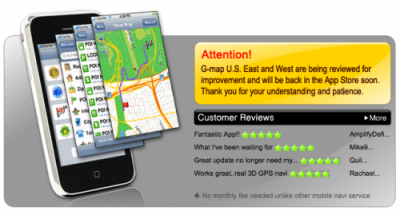
In reality G-Map was a true offline browser, and the last update had also added the voice features combined with turn-by-turn directions. All these additions surprised us, because they violated the contract terms of SDK. About 10 days ago, we wrote that G-Map app had suddenly been removed from App Store.
The developers, on the official site, continue to exhibit the same banner which claim G-Map will be back in AppStore, and that the application was removed only because of a major upgrade. This is a very strange this thing, because usually you update applications directly, without any need to first be removed.
iPhone OS 3.0 is coming
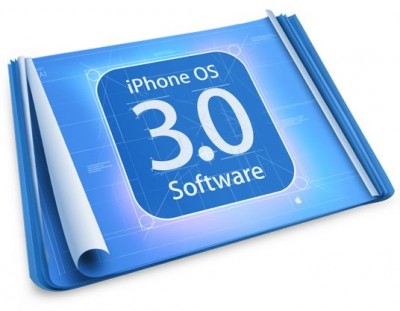
Engadget has just posted:
"We just got the announcement, iPhone OS 3.0 is coming. Set your clocks, mark your calendars. It's going down March 17th. Apparently, we'll get a sneak peak at the new OS, as well as a look at a brand new version of the SDK."
The event will take place at 10:00 a.m. Pacific time on Tuesday March 17th in the intimate setting of the Apple Town Hall.
iPhone 2.2.1 SDK
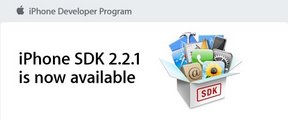
Apple has release an update to their SDK (software developer kit). This was done hours after apple releases their update to their iPhone iTouch firmware. To download the sdk you just need to log in to the .
iPhone firmware 2.2 beta 2

Apple has seeded iPhone 2.2 Firmware Beta 2 and has fully enabled Google Street View. Beta 1 of iPhone 2.2 had hidden APIs related to the Street View for Google Maps, but was not enabled.
The seed notes also indicated that Line-in audio accessories are now supported in the SDK.

via theiphoneblog and macrumors
Firmware 2.2 - new Safari interface
Apple just published firmware 2.2 beta 1 for developers. It is accompanied by a new beta of the iPhone SDK (build 9M2611). There are not much news about new features and improvements... but iphoneatlas already published a screenshot of new Safari interface, that is in firmware 2.2:
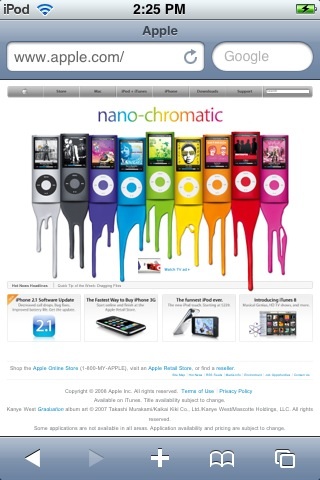
The new MobileSafari doesn't have the magnifying glass and refresh buttons at the top of the screen. There are the URL bar and search fields side-by-side instead. It looks much like the desktop version. Page refreshes are now accomplished via a tiny icon located inside the URL bar.
via iphoneatlas
OpenClip - Copy/Paste for iPhone

One of the common complaints about Apple’s iPhone–and one that did not get solved with the launch of the iPhone 3G–is the lack of a copy-paste function. An independent developer Zac White has taken matters in his own hands and founded a non-profit, open source, community project called which is offering iPhone developers a free Copy and Paste framework that will add this functionality to their applications.
iPhone 2.1 Beta 3
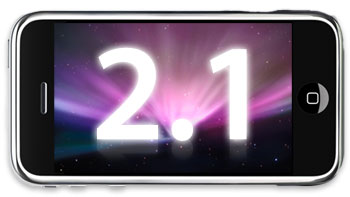
iPhone OS 2.1 beta 3 is now available and is to be used for testing only. View the Pre-Installation Advisory for iPhone OS 2.1 beta 3, Readme, and Release Notes before installing the new versions of the iPhone OS and SDK. As a reminder, pre-release software is Confidential Information and is subject to the terms outlined in your Registered iPhone Developer Terms and Conditions with Apple.
Again, there were 8 betas released for 2.0 between March and July. If Apple keeps this up, could we be looking at a September release for 2.1?
Related links:
Firmware 2.1 beta2 is out
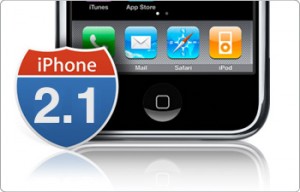
Just a week after the first iPhone 2.1 beta seed, Apple has released another 2.1 firmware release to developers. The new version appears to include several bug fixes.
"This is the second beta of the iPhone SDK targeting iPhone OS 2.1, including bug fixes to iPhone OS as well as an early implementation of the Apple Push Notification Service API. This API is not yet integrated with a live push server."
Related posts:
MagixPad - notes app with copy/paste
This video walkthrough of MagicPad, a rich text editor app that is still pending acceptance into the App Store, is notable for showing the first working copy and paste framework on the iPhone (at the 1:00 mark). Of course, SDK limitations keep the functionality quarantined within MagicPad itself, but its developers, Proximi, hope to use it as a case study for pushing forward one of the iPhone software's most wanted features.
via gizmodo
Related posts:
Вышла новая IPhone SDK

New IPhone SDK (build 9M2199a) is avaliable. Download . It's about 1.2 Gb.
JavaOne 2008 and IPhone-related sessions

is one of the most interesting events in IT industry. We are expecting a lot of talks about Java and other technologies. One IPhone+Java - related talk was already mentioned at Java4IPhone.com (). There are couple more of them.
- How to Port phoneME™ Advanced Software to Google Android, iPhone, OpenMoko, LiMO, and MoreHinkmond Wong (Sun Microsystems)
May 07, 14:50 - 15:50
- Dancing Duke on Your PlayStation Portable: Porting phoneME™ Software to PlayStation Portable Max Mu (Sun Microsystems); Kuo Wang (iaSolution Technology Limited)
May 08,19:30 - 20:20
- Extending Swing to Run Multitouch Applications (Multitouch Software)Michael Riecken (Trissential, LLC)
May 09,16:10 - 17:10
Sessioin details:
 Leave a comment, read comments [1]
Leave a comment, read comments [1]
How to Port phoneME Advanced Software to iPhone

The objective of the phoneME project is to further expand the usage of Java™ Platform, Micro Edition (Java ME platform) technology in the mobile handset market. The goal in making these technologies available to the Mobile & Embedded Community is to reduce implementation variation, increase the rate of innovation and enable new devices to leverage the power of the Java ME platform.
During 2008 conference at San Francisco senior staff engineer Hinkmond Wong (Java Micro Edition group at Sun Microsystems) will speak about porting phoneME Advanced Software to different mobile platporms, including IPhone:
Session Title: "How to Port phoneME™ Advanced Software to Google Android, iPhone, OpenMoko, LiMO, and More".
Session Abstract: "This presentation discusses how to port phoneME™ Advanced open source mobile platform software to the latest hot cell phone and embedded device environments such as Google-OHA, Android SDK, iPhone/iPod (touch) SDK, OpenMoko, and LiMO.
The objective of the phoneME project is to further expand the use of the Java™ Platform, Micro Edition (Java ME platform) in the mobile handset market through open source. The project scope includes a focus on the emerging next-generation phone segment with the phoneME Advanced software stack. This session concentrates on how to use the open-source phoneME Advanced project as the core Java virtual machine and libraries to enable the most-recent popular mobile development platforms to become Java technology-enabled. "
Make sure to attend this event and this sesson in particular. Hinkmond Wong is an expert from Sun Microsystems, who can answer many questions about IPhone, Java and more.
 Leave a comment, read comments [4]
Leave a comment, read comments [4]
Official Sun Microsystems announcement
 Eric Klein, vice president of Sun Microsystems, Java Marketing anounced that Sun will be developing a Java VM for the Apple's IPhone. This JVM will be based on Java Micro Edition and will allow IPhone to launch thousands of existing and new Java applications. "Once our JVM is on the phone, we anticipate that a large number of Java applications would run on the phone," Klein said. It took 24 hours for Sun to analyze the licence and information Apple had provided with IPhone's SDK. Release date is planned some time after June 2008.
Eric Klein, vice president of Sun Microsystems, Java Marketing anounced that Sun will be developing a Java VM for the Apple's IPhone. This JVM will be based on Java Micro Edition and will allow IPhone to launch thousands of existing and new Java applications. "Once our JVM is on the phone, we anticipate that a large number of Java applications would run on the phone," Klein said. It took 24 hours for Sun to analyze the licence and information Apple had provided with IPhone's SDK. Release date is planned some time after June 2008.
Download the official recordings: (335 kb), (4.9 mb).